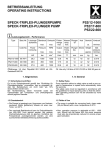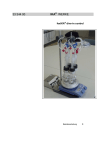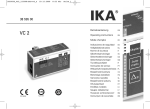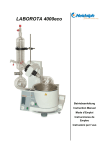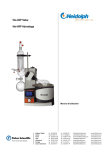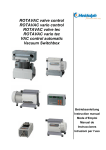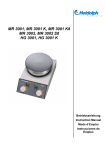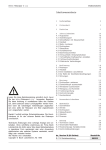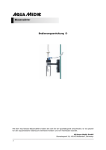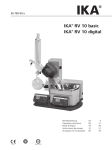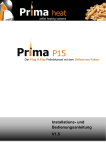Download D - Masterflex
Transcript
VV Micro Betriebsanleitung Instruction manual Mode d’Emploi IDI IEI IFi DEUTSCH Seite 3 - 17 ENGLISH page 18 - 31 FRANCAISE page 32 - 47 2 D Wir danken Ihnen für den Kauf dieses Gerätes. Sie haben ein Produkt erworben, das von der Firma Heidolph Instruments nach DIN EN ISO 61010 gefertigt und geprüft wurde. Mit diesem Gerät werden Sie Ihre Arbeit einwandfrei und problemlos durchführen können. INHALT INHALT................................................................................................................................3 LIEFERUMFANG UND ZUBEHÖR .....................................................................................4 ALLGEMEINE HINWEISE...................................................................................................4 SICHERHEITSHINWEISE ...................................................................................................5 AUFBAU..............................................................................................................................6 1. ANTRIEB ................................................................................................................7 2. DAMPFDURCHFÜHRUNGSROHR UND VERDAMPFUNGSKOLBEN ......................................7 3. KÜHLER ................................................................................................................7 4. EINLEITUNGSROHR .................................................................................................8 5. AUFFANGKOLBEN ...................................................................................................8 6. EINSTELLUNG FÜR ABDESTILLATION .........................................................................8 7. EINSTELLUNG RÜCKFLUß-DESTILLATION ...................................................................8 8. KÜHLWASSER- UND VAKUUMANSCHLÜSSE.................................................................9 9. TEILELISTE GLASSATZ V MICRO ...............................................................................9 BEDIENUNG UND BETRIEB..............................................................................................9 HINWEISE ZU DESTILLATIONSEINSTELLUNGEN........................................................11 10. DREHZAHL DES VERDAMPFUNGSKOLBENS ...............................................................11 11. TEMPERATURDIFFERENZ ZWISCHEN HEIZBAD UND DAMPFTEMPERATUR .....................11 12. TEMPERATURDIFFERENZ ZWISCHEN DAMPFTEMPERATUR UND KÜHLMEDIUM ...............11 13. LÖSUNGSMITTELDATEN .........................................................................................11 REINIGUNG UND WARTUNG ..........................................................................................14 ABBAU, TRANSPORT UND LAGERUNG .......................................................................14 ENTSORGUNG .................................................................................................................14 STÖRUNGEN UND DEREN BESEITIGUNG ....................................................................15 TECHNISCHE DATEN ......................................................................................................15 GARANTIE, HAFTUNG UND URHEBERRECHTE ..........................................................16 FRAGEN / REPARATUREN .............................................................................................16 CE-KONFORMITÄTSERKLÄRUNG .................................................................................17 Wichtiger Hinweis Hinweis zur Anschlussleitung / Netzanschluss Achtung, unbedingt beachten Achtung, Brand- oder Explosionsgefahr Achtung: Verbrennungsgefahr, heisse Oberfläche Hinweis zur Reparatur / Wartung 3 D LIEFERUMFANG UND ZUBEHÖR Bezeichnung 2 3 1 1 1 Bestellnummer Bestellnummer 230/240V 50/60Hz 115V 50/60Hz 511-10400-00 511-10400-07 511-10300-00 511-10300-02 513-10000-00 513-10000-00 1 1 1 1 1 1 1 23-09-03-01-01 22-03-02-01-03 515-01000-00 24-03-07-01-02 11-008-010-10 14-007-003-81 01-005-001-58 Menge Heizbad VV-Micro Antrieb VV-Micro Glassatz V-Micro Lose Teile: 9 Verschraubung bearb. 10 Spannfeder 11/12 Dichtung kpl. 16 PTFE VV-micro 7 Haltestange 15 Klemme kpl. Geräteanschlußleitung Betriebsanleitung 23-09-03-01-01 22-03-02-01-03 515-01000-00 24-03-07-01-02 11-008-010-10 14-007-003-89 01-005-001-58 ALLGEMEINE HINWEISE Bitte packen Sie das Gerät sorgfältig aus. Achten Sie auf mögliche Beschädigungen und melden Sie Schäden oder fehlende Teile unverzüglich dem Lieferanten. Lesen Sie die Betriebsanleitung bitte gründlich und aufmerksam und sorgen Sie dafür, dass jeder Betreiber des Gerätes vor Inbetriebnahme die Betriebsanleitung sorgfältig gelesen hat. Bitte bewahren Sie die Betriebsanleitung an einem für jedermann zugänglichen Ort auf. Die Geräte sind standardmässig mit einem EURO- Stecker (DIN 49441 CEE 7/VII 10/ 16 A 250 V) versehen. Für Nordamerika mit einem US.NORM Stecker (NEMA Pub.No.WDI.1961 ASA C 73.1 . 1961 Seite 8 15A 125V). Falls Sie das Gerät in einem Land mit anderem Stecker-System betreiben möchten, müssen Sie einen zugelassenen Adapter verwenden oder der mitgelieferte Stecker muss durch einen Fachmann ausgewechselt und durch einen für dieses Netz passenden und zugelassenen Stecker ersetzt werden. Bei Lieferung ist das Gerät geerdet. Beim Auswechseln des Originalsteckers achten Sie bitte unbedingt darauf, dass der Schutzleiter am neuen Stecker angeschlossen wird! 4 D SICHERHEITSHINWEISE Bitte beachten Sie alle im Labor geltenden Sicherheits- und Unfallverhütungsvorschriften! Beim Betrieb von Rotationsverdampfern ist die erforderliche Sorgfaltspflicht anzuwenden. Während des Betriebes Augenschutz und geeignete Arbeitskleidung tragen. Äusserste Vorsicht beim Umgang mit leicht entzündlichen Medien. Beachten Sie die Sicherheitsdatenblätter. Vorsicht bei der Anwendung in der Nähe von leicht entzündlichen und explosiven Stoffen. Die Motoren arbeiten zwar funkenfrei, das Gerät ist jedoch nicht explosionsgeschützt. Bitte achten Sie vor der Verbindung des Gerätes mit dem Stromnetz darauf, dass die Netzspannung mit den Angaben auf dem Typenschild übereinstimmt. Bitte schliessen Sie das Gerät nur an eine geerdete Netzsteckdose an. Schalten Sie den Netzschalter aus, wenn das Gerät nicht in Betrieb ist, bzw. bevor es vom Netz genommen wird. Achtung! Verbrennungsgefahr beim Betrieb des Heizbades über 60°C. Heissen Metallrand des Badbehälters, Verdampferkolben und Badflüssigkeit nicht berühren. Zum Wechsel des Verdampferkolbens geeigneten Wärmeschutzhandschuh benutzen. Heizbad nie ohne Flüssigkeit betreiben. Reparaturen dürfen nur von einem von Heidolph Instruments autorisierten Fachmann ausgeführt werden. Bitte achten Sie auf sicheren Stand des Gerätes! Den Rotationsverdampfer auf einer glatten, horizontalen Tischfläche aufstellen. Darauf achten, dass im Bewegungsraum des Verdampfers genügend Sicherheitsabstand gewährleistet ist! Darauf achten, dass niemals Überdruck im System entstehen kann. Explosionsgefahr. Beim Arbeiten ohne Vakuum aus Sicherheitsgründen Belüftungshahn öffnen, um unzulässigen Überdruck zu vermeiden 5 D AUFBAU Vor dem Aufbau beachten Sie bitte die allgemeinen Informationen und Sicherheitshinweise! 6 D 1. Antrieb Antrieb mit Klemmring (4) an der Haltestange (1) befestigen. Die schwarze Überwurfmutter (9) muß nach innen in Richtung des Heizbades (2) weisen und das elektrische Anschlußkabel (6) muß nach unten führen. Den Klemmring (4) einschließlich der Antriebseinheit durch Festziehen des Sterngriffes (5) an der Haltestange (1) befestigen. Anschlußkabel mit Stecker (6) in entsprechende Buchse auf der Rückseite des Heizbadgehäuses (2) stecken. Die Haltestange (7) für den Kühler in die Gewindebohrung der Verbindungsmuffe (8) schrauben. 2. Dampfdurchführungsrohr und Verdampfungskolben Die schwarze Uberwurfmutter (9), den Federspannring (10), die Dichtung PTFE (11) und den Silikonring (12) vom Antrieb entfernen. Das Dampfdurchführungsrohr (A) mit dem schwarzen Sicherungsring (B) »von der Seite mit dem roten Sicherungsknopf (14)« bis zum Anschlag in die Antriebseinheit einstecken. Der seitliche Auslaß des Dampfdurchführungsrohres muß parallel zur Haltestange (7) sein. Den Silikonring (12) auf das Dampfdurchführungsrohr (A) schieben (von der Badseite aus) - mit der gewölbten Fläche zuerst. Danach die Dichtung PTFE (11) soweit wie möglich (mit der Dichtlippe voraus) auf das Dampfdurchführungsrohr (A) setzen. Zuerst die Überwurfmutter (9), dann den Federspannring (10) auf den Hals des Verdampfungskolbens (C,D,E) oder des Übergangsstückes (F) setzen. 13 Den Flansch des Kolbens über das Dampfdurchführungsrohr (A) in den Antrieb und gegen die Dichtung setzen. Den Kolben soweit wie möglich drücken und Überwurfmutter (9) mäßig festziehen. Zur ausreichenden Befestigung der Überwurfmutter und des Kolbens den Halteknopf (13) drücken und damit das Getriebe blockieren (siehe Abbildung). 3. Kühler Bei aufrechter Position des Kühlers läßt sich der Glassatz leichter montieren. Dazu sollte die Haltestange (7) senkrecht 14 stehen. Andernfalls den roten Sicherungsknopf (14) lockern und Halteknopf (13) herausziehen, so daß die Verbindungsmuffe (8) um 180° geschwenkt werden kann. Der Halteknopf (13) schnappt dann ein und die Haltestange steht aufrecht. Roten Sicherungsknopf (14) wieder festziehen. Den Stumpfverbindungsflansch (G) auf den seitlichen Gewindestutzen des Dampfdurchführungsrohres (A) schrauben und den Dichtungsring (G1) einsetzen. Klemme (15) auf die Haltestange (7) stecken und den Kühler (H) mittels der Klemme an der Haltestange befestigen. Sicherstellen, daß sich die Wasser- und Vakuumanschlüsse des Kühlers am oberen Ende befinden. Mittels Stumpfverbindungsflansch (G) die Kühlereinheit 7 D (H) auf das Dampfdurchführungsrohr (A) schrauben. Roter Sicherungsknopf (14) muß festgezogen sein, damit Kühler und Haltestange abgesichert sind. 4. Einleitungsrohr Die Lochschraubkappe (l) und die Dichtung (l1) auf das Einleitungsrohr (K) setzen. Danach das Einleitungsrohr in das offene Ende des Dampfdurchführungsrohrs (A) einsetzen und die Lochschraubkappe (l) festziehen. Das Ventil des Einleitungsrohres ist aus PTFE und wird fettfrei betrieben. 5. Auffangkolben Stumpfverbindungsflansch (G) auf das offene Ende des Kühlers (H) schrauben, Dichtungsring (G1) und den Auffangkolben (L,M,N) oder den Vakuumverschluß (0) auf das andere Ende der Einheit schrauben (jeweils entsprechend der Destillationsmethode). 6. Einstellung für Abdestillation (ausgehend von Position RückflußDestillation) Auffangkolben schaut nach unten (siehe Abbildung). Den roten Sicherungsknopf (14) lockern, Halteknopf (13) herausziehen und den Kühler um 180° schwenken (einschließlich Kolben und Haltestange), bis der Halteknopf (13) in der zweiten Position einklinkt. Danach roten Sicherungsknopf (14) wieder festziehen. 7. Einstellung Rückfluß-Destillation (Ausgehend von Position Abdestillation) Bei der Rückfluß-Destillationsmethode steht der Kühler in aufrechter Position (siehe Abbildung) und statt des Auffangkolbens (L) wird ein Vakuumverschluß (0) verwendet. Zur Positionsänderung wiederum den Sicherungsknopf (14) lockern, Halteknopf (13) herausziehen und den Kühler einschließlich Kolben und Haltestange um 180° schwenken, bis Halteknopf (13) einklinkt. Danach Sicherungsknopf (14) festziehen. 8 D 8. Kühlwasser- und Vakuumanschlüsse Kühlwasseranschlüsse (H2) und Vakuumanschluß (H1) seitlich am Kühler anschließen und durch Schlauchschellen sichern (nicht im Lieferumfang enthalten). 9. Teileliste Glassatz V Micro Bestell-Nr.: 514-40000-00 514-72100-00 514-71100-00 514-70100-00 514-33000-00 514-45000-00 514-20000-00 514-46000-00 514-50000-00 514-82100-00 514-81100-00 514-80100-00 514-34000-00 Pos. A+B C D E F G + G1 H I + I1 K + K1 L M N O Bestellbezeichnung Dampfdurchführungsrohr mit Auflagering Verdampferkolben 250 ml Verdampferkolben 100 ml Verdampferkolben 50 ml Übergangsstück NS 14,5 Stumpfverbindungsflansch mit Dichtung Kühler K-micro Lochschraubkappe mit Dichtung Einleitungsrohr mit Ventil Auffangkolben 250 ml Auffangkolben 100 ml Auffangkolben 50 ml Vakuumverschluß Stück 1 1 1 1 1 1 1 1 1 1 1 1 1 BEDIENUNG UND BETRIEB Achtung: Vor Inbetriebnahme des Gerätes unbedingt die Sicherheitshinweise und allgemeinen Informationen lesen! Vor der Verbindung des Gerätes mit dem Netz darauf achten, daß Gerätespannung und Netzspannung übereinstimmen. Dementsprechend auch landesübliche Stecker verwenden. Siehe hierzu auch Hinweis unter allgemeine Hinweise Seite 4 o Alle beteiligten Komponenten und deren Funktion überprüfen! o Auf Dichtheit aller Anschlüsse achten. o Wasser ins Heizbad füllen. Die Minimum-/Maximumangaben beziehen sich auf den Flüssigkeitspegel bei eingetauchtem Verdampfungskolben 16 o Wasser oder alternative Flüssigkeit durch den Kühler laufen lassen. o Lösungsmittel in den Verdampfungskolben geben. o Verdampfungskolben mit Feststellknopf (16) und Sterngriff (5) so im Heizbad positionieren, daß zur Badbehälterwand ein Sicherheitsabstand von mindestens 10 mm eingehalten wird. (siehe Abbildung). Vorher nicht 9 D den Schalter (17) für die Kolbenrotation einschalten. o Bei Verwendung von entionisiertem oder destilliertem Wasser: Wasser mit 0,2% Borax (Na2 B4 O7*10 H2O) versetzen o Die Eintauchtiefe des Verdampferkolbens in der Badflüssigkeit wird durch die Höhenverschiebung des gesamten Antriebes eingestellt. Dazu Antriebseinheit (3) festhalten, Sterngriff (5) lösen, Antrieb entsprechend verschieben und Sterngriff wieder festziehen. o Die Badheizung wird mit dem Schalter (18) eingeschaltet (Kontrollampe leuchtet). Mit dem Drehknopf (20) wird die Badtemperatur gewählt. Achtung: Verbrennungsgefahr beim Betrieb des Heizbades! Zur Sicherheit wird die Heizbadtemperatur durch einen zusätzlichen Maximaltemperaturbegrenzer überwacht. Fällt der Temperaturregler aus, schaltet der Maximaltemperaturbegrenzer die Heizung bleibend ab. o Der Maximaltemperaturbegrenzer befindet sich an der Unterseite des Heizbades. Hat er abgeschaltet, muß das Gerät geöffnet werden, um den roten, herausgesprungenen Knopf am Boden des Heizbades wieder einzurücken und den Maximaltemperaturbegrenzer damit nach ausreichender Abkühlung wieder zurückzustellen. o Spricht der Maximaltemperaturbegrenzer an, ist grundsätzlich eine Überprüfung des Heizbades durch einen von Heidolph autorisierten Servicetechniker notwendig. o Die Kolbenrotation wird mit dem Schalter (17) eingeschaltet (Kontrollampe leuchtet), wobei Drehknopf (19) auf 0 (Linksanschlag) stehen muß. Mit Drehknopf (19) anschließend die gewünschte Drehzahl einstellen. o Wenn das System unter Vakuum steht, kann Lösungsmittel in den Verdampferkolben nachdosiert werden. Hierzu das Einleitungsrohr (K) mit einem Schlauchstück (di ~ 6 mm) verbinden. Das Schlauchende in den Lösungsmittelbehälter geben. Mit dem Ventil (K1) kann die gewünschte Menge dosiert werden. o Der VV Micro kann während des Betriebes von Rückflußdestillation auf Abdestillation umgestellt werden. Achtung: Vor Destillationsbeginn einen ausreichend großen Auffangkolben einsetzen. Zur Umstellung Sicherungsknopf (14) lösen, Halteknopf (13) herausziehen und den Kühler um 180° schwenken, bis Halteknopf (13) einrastet. Sicherungsknopf (14) wieder festziehen. o Nach Beendigung der Destillation den Verdampferkolben durch Lösen des Sterngriffes (5) und Verschieben der Antriebseinheit aus dem Bad heben. 10 20 18 17 19 D o Bitte vor einem ersten Laboreinsatz eine allgemeine Funktionsprüfung von Schaltern, Drehknöpfen, Antrieb usw. durchführen. HINWEISE ZU DESTILLATIONSEINSTELLUNGEN Bei der Verwendung eines Rotationsverdampfers zur thermischen Stofftrennung sollten verschiedene Punkte beachtet werden, um bestmögliche Destillationsergebnisse zu erzielen. Für eine optimale Einstellung müssen folgende Parameter berücksichtigt werden: 10. Drehzahl des Verdampfungskolbens Durch Erhöhung der Drehzahl lässt sich die Destillationsgeschwindigkeit steigern. Dies trägt durch die verkürzte Destillationszeit zur thermischen Schonung des Destillationsgutes bei. 11. Temperaturdifferenz zwischen Heizbad und Dampftemperatur Diese Temperaturdifferenz sollte bei mindestens 20 K liegen, um eine ausreichend hohe Destillationsgeschwindigkeit zu erreichen. Wenn es die thermische Stabilität des Destillationsgutes erlaubt, kann die Temperaturdifferenz auch größer gewählt werden. Faustregel: die Verdoppelung der Temperaturdifferenz führt zu einer Verdoppelung der Destillationsgeschwindigkeit. 12. Temperaturdifferenz zwischen Dampftemperatur und Kühlmedium Diese Temperaturdifferenz sollte ebenfalls bei mindestens 20 K liegen, um eine ausreichende Kondensation zu gewährleisten. Bei zu niedriger Temperaturdifferenz wird die Effektivität der Lösungsmittelrückgewinnung verschlechtert. Insbesondere bei Substanzen mit hoher Verdampfungswärme sollte eher eine größere Temperaturdifferenz gewählt werden. 13. Lösungsmitteldaten Beispiele für die Anwendung der Tabelle und des Nomogramms: Die Tabelle gibt die für die Destillation wichtigsten Stoffdaten wieder, das Nomogramm gibt die Beziehung zwischen Druck und Siedetemperatur einiger Lösungsmittel wieder. Hierfür wurde entsprechend der Gleichung von Clausius-Clapeyron 1/T gegen log p aufgetragen. 13.1. bei Siedetemperatur 40°C Am Vakuumcontroller wird der in der Spalte „Vakuum für Sdp. bei 40°C angegebene Wert als Sollwert Set Vac eingestellt. 11 D 13.2. bei Siedetemperaturen ungleich 40°C 1. Auf der Temperaturachse des Nomogramms wird der gewünschte Siedepunkt markiert. 2. Durch ziehen einer Linie nach rechts wird der Schnittpunkt mit der LösungsmittelGeraden ermittelt. 3. Von diesem Schnittpunkt senkrecht nach unten kann das notwendige Vakuum abgelesen werden. 13.3. bei Lösungsmitteln die nicht aufgeführt sind - Für die Ermittlung des richtigen Vakuums können folgende Punkte eine Hilfestellung sein: 1. Die Steigung der Geraden wird durch die Verdampfungsenthalpie bestimmt. Sie ist für chemisch verwandte Substanzen mit naheliegendem Siedepunkt ähnlich. Die eingezeichneten Geraden können somit als Orientierung für Substanzen mit leicht abweichendem Siedepunkt dienen. 2. Mit einer Wasserstrahl- oder Membranpumpe lässt sich eine Siedepunkterniedrigung von ca. 100 °C erreichen. 3. Faustregel: Die Reduzierung des Druckes um die Hälfte erniedrigt den Siedepunkt um etwa 15 °C. 12 D Lösungsmittel Aceton Acetonitril Benzol n-Butanol (Butylalkohol) tert.-Butanol (tert.-Butylalkohol) 2-Butanon (Methylethylketon) tert.-Butylmethylether Chlorbenzol Cyclohexan 1,2-Dichlorethan 1,2-Dichlorethylen (cis) 1,2-Dichlorethylen (trans) Dichlormethan (Methylenchlorid) Diethylether Diisopropylether Dimethylformamid 1,4-Dioxan Ethanol Ethylacetat Heptan Hexan Methanol 3-Methyl-1-Butanol (Isoamylalkohol) Pentachlorethan Pentan n-Pentanol (Amylalkohol) 1-Propanol (n-Propylalkohol) 2-Propanol (Isopropylalkohol) 1,1,2,2-Tetrachlorethan Tetrachlorethylen Tetrachlormethan (Carbontetrachlorid) Tetrahydrofuran Toluol 1,1,1-Trichlorethan Trichlorethylen Trichlormethan (Chloroform) Wasser Xylol (Isomeren-Gemisch) Summenformel MW [g/mol] Sdp. [°C] ΔHvap [J/g] C3H6O C2H3N C6H6 C4H10O C4H10O C4H8O C5H12O C6H5CI C6H12 C2H4CI2 C2H2CI2 C2H2CI2 CH2CI2 C4H10O C6H14O C3H7NO C4H8O2 C2H6O C4H8O2 C7H16 C6H14 CH4O C5H12O C2HCI5 C5H12 C5H12O C3H8O C3H8O C2H2CI4 C2CI4 CCI4 C4H8O C7H8 C2H3CI3 C2HCI3 CHCI3 H2O C8H10 58,08 41,05 78,11 74,12 74,12 72,11 88,15 112,60 84,16 98,96 96,94 96,94 84,93 74,12 102,20 73,09 88,11 46,07 88,11 85,09 86,18 32,04 88,15 202,30 72,15 88,15 60,10 60,10 167,90 165,80 153,80 72,11 92,14 133,40 131,40 119,40 18,02 106,20 56,5 81,8 80,1 117,5 82,9 79,6 55,0 132,2 80,7 82,4 59,0 47,8 40,7 34,6 67,5 153,0 101,1 78,4 77,1 98,4 68,7 64,7 130,6 160,5 36,1 137,8 97,8 82,5 145,9 120,8 76,7 66,0 110,6 74,1 86,7 61,3 100,0 137-143 550 833 549 619 588 473 13 375 389 336 320 313 373 392 318 406 879 394 439 370 1225 593 203 382 593 787 701 247 233 225 425 251 265 263 2259 390 Vacuum für Sdp bei 40°C [mbar] 556 230 236 25 130 243 36 235 210 479 751 atm. atm. 375 11 107 175 240 120 335 337 14 13 atm. 11 67 137 35 53 271 357 77 300 183 474 72 25 D REINIGUNG UND WARTUNG Zur Reinigung Gehäuse und Oberfläche des Gerätes mit einem feuchten Tuch (milde Seifenlauge) abwischen. HINWEIS: Auf keinen Fall zur Reinigung Chlorbleiche, auf Chlorbasis aufbauende Putzmittel, Scheuermittel, Ammoniak, Putzwolle oder Reinigungsmittel mit metallischen Bestandteilen verwenden. Die Oberfläche des Gerätes würde dadurch Schaden erleiden. Dampfdurchführung (A+B Seite 6) und Dichtung PTFE (11/12 Seite 6) bedürfen einer regelmäßigen Wartung. Dazu Dampfdurchführung (A+B) und Dichtung PTFE (11/12) ausbauen, reinigen und überprüfen (Dichtlippe). Die Dichtung PTFE ist gegebenenfalls auszutauschen. Montage von Dampfdurchführung und Dichtung PTFE siehe Kapitel 2. Das Gerät ist wartungsfrei. Eine eventuell notwendige Reparatur ist unbedingt von einem durch Heidolph autorisierten Fachmann auszuführen. Wenden Sie sich hierzu an Ihren HEIDOLPH-Händler bzw. an die HEIDOLPH-Vertretung. ABBAU, TRANSPORT UND LAGERUNG Abbau o o Gerät abschalten und Netzstecker aus der Steckdose ziehen (abkühlen lassen). Gerätschaften um den Verdampfer herum entfernen, damit das Gerät problemlos abgebaut werden kann. Den Glassatz entfernen und gesamtes Gerät und Geräteteile in umgekehrter Reihenfolge wie beim Aufbau demontieren. Transport und Lagerung 1. Das Gerät und seine Teile in der Originalverpackung lagern oder in einem anderen geeigneten Behälter, um Schäden während eines Transportes zu vermeiden. Die Verpackung mit Klebestreifen verschließen. 2. Das Gerät ist an einem trockenen Ort aufzubewahren. Vorsicht: Beim Transport des Gerätes ist darauf zu achten, dass Stöße und Erschütterungen vermieden werden. ENTSORGUNG Wir bitten Sie, darauf zu achten, Altgeräte bzw. defekte Geräteteile bei einer Sammelstelle fachgerecht entsorgen zu lassen. Trennen Sie bitte auch das Altmaterial in Metall, Glas, Kunststoff usw. Entsorgen Sie bitte auch das Verpackungsmaterial umweltgerecht (Materialtrennung). 14 D STÖRUNGEN UND DEREN BESEITIGUNG Keine Heizfunktion: o Netzleitung überprüfen o Kapillarrohrregler defekt o Schalter ein/aus defekt o Rohrheizkörper defekt Antrieb dreht nicht: o Steckdose führt keinen Strom o Netzleitung und Verbindungskabel zum Basisgerät überprüfen o Einstellpotentiometer defekt o Schalter ein/aus defekt o zu niedrige Drehzahl eingestellt o schwarze Überwurfmutter wurde zu stark angezogen o Motor defekt o Motorkondensator defekt Kein ausreichendes Vakuum: o Dichtungen und Anschluß (insges. 6 Stellen) überprüfen o evtl. verschlissene Dichtungen erneuern o auf korrekten Sitz der Dichtung achten (Dichtlippe ins Gerät, vergl. Zeichnung Seite 6) TECHNISCHE DATEN Modell VV-Micro Antrieb Kondensatormotor mit Drehzahlsteuerung Drehzahlbereich (1/min) 80 - 200 Drehzahlkontrolle Skala Heizleistung (W) 500 Temperaturbereich Wasserbad (°C) 30 - 100 Regelgenauigkeit Wasserbad (°C) ±5 Anzeige Badtemperatur Skala Material Heizbad Chromstahl Durchmesser Heizbad (mm) 139 Anschlußspannung 230 V / 50 Hz o. 115V/60Hz (auch andere) Anschlußleistung (W) 530 Gewicht ohne Glassatz (kg) 6,9 Abmessungen** (B xTxH) (mm) 167x235x350 Länge Anschlußkabel (m) 2 Schutzart IP 21 Zulässige Umgebungsbedingungen 0 - 40° C bei 80 % Luftfeuchtigkeit Verdampfungsleistung (ml H2O / h) ca. 250 Kühlfläche (cm2) 270 Bestellnummer 511.12000.00 **Antrieb in oberster Position, ohne Glassatz 15 D GARANTIE, HAFTUNG UND URHEBERRECHTE Garantie Die Firma Heidolph Instruments gewährt Ihnen auf die hier beschriebenen Produkte (ausgenommen Glas- und Verschleißteile) eine Garantie von drei Jahren, wenn Sie sich mit beiliegender Garantiekarte oder per Internet registrieren (www.heidolph.com). Die Garantie beginnt mit der Registrierung. Ohne Registrierung hat die Seriennummer des Gerätes Gültigkeit. Diese Garantie umfasst Material- und Herstellungsfehler. Transportschäden sind ausgeschlossen. Im Falle eines Garantieanspruchs benachrichtigen Sie bitte Heidolph Instruments (Tel.: (+49) 9122 - 9920-69) oder Ihren Heidolph Instruments Händler. Wenn es sich um einen Material- oder Herstellungsfehler handelt, wird Ihnen im Rahmen der Garantie das Gerät kostenfrei repariert oder ersetzt. Für Schäden durch unsachgemäße Behandlung kann von der Firma Heidolph Instruments keine Garantie übernommen werden. Eine Änderung dieser Garantieerklärung bedarf in jedem Fall einer schriftlichen Bestätigung durch die Firma Heidolph Instruments. Haftungsausschluss Für Schäden durch unsachgemäße Behandlung und Verwendung kann von der Firma Heidolph Instruments keine Haftung übernommen werden. Folgeschäden sind von der Haftung ausgeschlossen. Urheberrecht Das Urheberrecht (Copyright) für alle Bilder und Texte in dieser Betriebsanleitung liegt bei Heidolph Instruments. FRAGEN / REPARATUREN Haben Sie nach dem Lesen der Betriebsanleitung noch Fragen zu Installation, Betrieb oder Wartung, wenden Sie sich bitte an die im Folgenden genannte Adresse. Bei Reparaturen wenden Sie sich bitte vorab telefonisch an Heidolph Instruments direkt (Tel.: (+49) 9122 - 9920-69) oder an Ihren autorisierten Heidolph Instruments Händler. Hinweis Bitte senden Sie Geräte ausschließlich nach vorheriger Rücksprache an diese Anschrift: Heidolph Instruments GmbH & Co. KG Vertrieb Labortechnik Walpersdorfer Str. 12 D-91126 Schwabach / Deutschland Tel.: +49 – 9122 - 9920-69 Fax: +49 – 9122 - 9920-65 E-Mail: [email protected] 16 D Sicherheitshinweis Bitte sorgen Sie bei der Anlieferung von Reparaturgeräten, die mit gefährlichen Arbeitsstoffen in Berührung gekommen sind für: Möglichst genaue Stoffangaben des entsprechenden Mediums Schutzmassnahmen zum sicheren Umgang für unser Annahme- und Wartungspersonal. Kennzeichnung der Verpackung gemäss der Gefahrenstoffverordng CE-KONFORMITÄTSERKLÄRUNG Wir erklären, dass dieses Produkt mit folgenden Normen und normativen Dokumenten übereinstimmt: EMV-Richtlinie: EN 61326: 1997 + A1:1998 + A2:2001+ A3 2003 EN 61000-3-2: 2000 EN 61000-3-3: 1995 + 1997 + A1:2001 EN 61326: 1997 + A1:1998 + A2: 2001+ A3 2003 EN 61000-4-3:2002 +A1:2002 EN 61000-4-5:1995 +A1:2001 EN 61000-4-6:1996 +A1:2001 EN 61000-4-8: 1993 EN 61000-4-11:1994 + A1:2001 Niederspannungs-Richtlinie: EN 61010-1 + EN 61010-2-010 17 E Thank you for purchasing a Heidolph Instruments product. This item has been designed, made and inspected in compliance with DIN EN ISO 61010 for long performance and continuous operation. SUMMARY SUMMARY ........................................................................................................................18 STANDARD ITEM PLUS OPTIONS .................................................................................19 GENERAL .........................................................................................................................19 SAFETY INFORMATION ..................................................................................................20 SET-UP..............................................................................................................................21 1. DRIVE UNIT ..........................................................................................................22 2. VAPOR SUPPORT TUBE AND EVAPORATION FLASK .....................................................22 3. CONDENSER ........................................................................................................22 4. INLET TUBE ..........................................................................................................23 5. COLLECTION FLASK ..............................................................................................23 6. SETTING UP FOR NORMAL DISTILLATION ..................................................................23 7. SETTING UP FOR REFLUX DISTILLATION ...................................................................23 8. COOLING WATER AND VACUUM CONNECTIONS .........................................................23 9. PART LIST GLASS SET V-MICRO .............................................................................24 CONTROLS AND OPERATION........................................................................................24 INFORMATION ABOUT DISTILLATION SETTINGS .......................................................25 10. ROTARY SPEED OF EVAPORATOR FLASK ..................................................................26 11. TEMPERATURE DIFFERENCE BETWEEN HOT BATH AND VAPOR ....................................26 12. TEMPERATURE DIFFERENCE BETWEEN VAPOR TEMPERATURE AND COOLANT ...............26 13. SOLVENT DATA .....................................................................................................26 CLEANING AND MAINTENANCE ....................................................................................28 DISASSEMBLE, FORWARD & STORE ...........................................................................28 DISPOSAL ........................................................................................................................28 TROUBLESHOOTING ......................................................................................................29 SPECIFICATIONS.............................................................................................................29 WARRANTY, LIABILITY & COPYRIGHT .........................................................................30 FAQ / REPAIR WORK ......................................................................................................30 CE-DECLARATION OF CONFORMITY............................................................................31 Important information Advice about power cord / mains supply Caution: mandatory action Caution: fire- and explosion hazard Caution: hazard of burns, hot surface Advice about maintenance / repair 18 E STANDARD ITEM PLUS OPTIONS Item Description 1 1 1 Order number Order number 230/240V 50/60Hz 115V 50/60Hz 511-10400-00 511-10400-07 511-10300-00 511-10300-02 513-10000-00 513-10000-00 1 1 1 1 1 1 1 23-09-03-01-01 22-03-02-01-03 515-01000-00 24-03-07-01-02 11-008-010-10 14-007-003-81 01-005-001-58 Qty 2 3 Heating bath VV-Micro Drive VV-Micro Glass set V-Micro loose parts: 9 Screw collar 10 Spring tension ring 11/12 PTFE seal 16 VV-micro 7 Support rod 7mm 15 Clamp complete Power cord Instruction manual 23-09-03-01-01 22-03-02-01-03 515-01000-00 24-03-07-01-02 11-008-010-10 14-007-003-89 01-005-001-58 GENERAL Unpack your item carefully. Inspect for damage and report such damage or missing parts to your supplier immediately. Read your Instruction Manual carefully. Take the time to read the manual which will save time while working with your product. Make sure that every user has read and understands the Instruction Manual. Please store the Instruction Manual in a place easily accessible to every user. IF ALL ELSE FAILS, READ THESE INSTRUCTIONS ! A so-called EURO-plug (DIN 49441 CEE 7/VII 10/ 16 A 250 V) is standard on all of the products. For the Continental US they feature a US-standard plug (NEMA Pub.No.WDI.1961 ASA C 73.1 . 1961 page 8 15A 125V). For using the item in a country with deviating outlet / plug systems, we recommend to use approved adapters or to have an electrician replace the standard plug with one mating your local system. As shipped, the item features a protective ground wire. When replacing the original plug, make sure to reconnect this protective ground wire in the new plug ! 19 E SAFETY INFORMATION Please comply with all safety and accident prevention regulations as in force for laboratory work ! Use extra care while working with rotary evaporators. Use eye protection and adequate clothing. Use extra care while working with flammable substances; refer to safety data sheets. Use extra care while working close to flammable and explosive substances. Motors are of non-sparking type, the item itself is not explosion-protected. Before connecting your item with the local power supply, make sure the item has been designed for your local voltage; refer to data plate on item. Connect your item with a grounded outlet only. Turn power switch to OFF when item is not in use, or before disconnecting from mains. Caution ! Hazard of burns when running the hot bath at temperatures exceeding 60°C. Avoid touching hot edge of bowl, evaporator flask and fluid in bowl. Use gloves when replacing evaporator flask. Never run hot bath dry. Repair work is limited to skilled personnel so authorized by Heidolph. Your item needs a solid stand. Locate the rotary evaporator on a smooth, horizontal table. Make sure not to obstruct area around evaporator. Avoid overpressure in the system. Explosion hazard. For reasons of safety open aerating valve, when working at ambient pressure, in order to avoid excessive overpressure. 20 E SET-UP Please read the sections „General Information" and „Safety Instructions" before you assemble the appliance. 21 E 1. Drive unit Mount the drive on the support rod (1) with the clamping ring (4). The black screw collar (9) must face inwards towards the heating bath and the electric power cable (6) must point down. Secure the clamping ring (4) with the drive unit by tightening the star grip (5) on the support rod (1). Insert the power cable with plug (6) in the correct socket on the rear of the heating bath housing (2). Screw the support rod (7) for the condenser in the threaded hole of the coupling (8). 2. Vapor support tube and evaporation flask Remove the black screw collar (9), the spring tension ring (10), the PTFE seal (11) and the silicon ring (12) from the drive. From the side with the red locking knob (14), insert the vapor tube (A) with the black support ring (B) in the drive unit as far as the stop. Make sure the side outlet of the vapor tube is parallel to the support rod (7). From the bath side, slide the silicon ring (12) - curved face first - on the vapor tube (A). Then slide the 13 PTFE seal (11) - sealing lip first - on the vapor support tube as far as it will go. Place first the screw collar (9) and then the spring tension ring (10) on the neck of the evaporation flask (C, D, E) or transition piece (F). Slide the flange over the vapor support tube (A) and into the drive up against the seal. Push the flask as far as it will go and half tighten the screw collar. To give the screw collar and flask sufficient hold, press the fastening knob (13) to lock the gear. 3. Condenser 14 The glass set is easier to mount when the condenser is in upright position. The support rod (7) should be vertical. If not, loosen the red locking knob (14) and pull out the fastening knob (13) so that the coupling (8) can be swivelled 180°. The fastening knob (13) will then latch home again and the support rod will be in upright position. Re-tighten the red locking knob (14). Screw the butt flange (G) to the threaded socket on the side of the vapor support tube (A) and insert the sealing ring (G1). Place the clamp (15) on the support rod (7) and fasten the condenser (H) to the support rod with the clamp. Make sure that the condenser's water and vacuum connections are at the top end. Using the butt flange (G), screw the condenser unit (H) to the vapor tube (A). The red locking button (14) must be tight in order to provide a secure hold for the condenser and support rod. 22 E 4. lnlet tube Place the screw connection cap (I) and the seal (I1) on the inlet tube (K). Then insert the inlet tube in the open end of the vapor tube and tighten the screw connection cap (I). Inlet valve is made of PTFE, please do not grease. 5. Collection flask Screw the butt flange (G) on the open end of the condenser (H) and screw the sealing ring (G1) and the collection flask (L, M, N) or vacuum cap (0) on the other end of the unit (according to the intended method of distillation). 6. Setting up for normal distillation (Starting from the position for reflux distillation) For normal distillation the collection flask has to point down. Slacken the red locking knob (14), pull out the fastening knob (13) and swivel the condenser (with flask and support rod) through 180° until the fastening knob (13) latches in the second position. Then re-tighten the red locking knob (14). 7. Setting up for reflux distillation (Starting from the position for normal distillation) For reflux distillation the condenser has to be in upright position and a vacuum cap (0) is used instead of the collection flask (L). To re-position the condenser, loosen the locking knob (14), pull out the fastening knob (13) and swivel the condenser with flask and support rod through 180° until the fastening knob (13) latches home. Then tighten the locking knob (14). 8. Cooling water and vacuum connections Join the cooling water connections (H2) and the vacuum connection (H1) to the side of the condenser and secure with hose clips (not supplied). 23 E 9. Part list Glass set V-Micro Order number 514-40000-00 514-72100-00 514-71100-00 514-70100-00 514-33000-00 514-45000-00 514-20000-00 514-46000-00 514-50000-00 514-82100-00 514-81100-00 514-80100-00 514-34000-00 Item A+B C D E F G + G1 H I + I1 K + K1 L M N O Description Vapor tube with Support ring Evaporation flask 250 ml Evaporation flask 100 ml Evaporation flask 50 ml Transition piece NS 14,5 Butt flange with Seal for butt flange Cooler K-micro Screw connection cap with Seal Inlet tube with Valve Collection flask 250 ml Collection flask 100 ml Collection flask 50 ml Vacuum cap Qty 1 1 1 1 1 1 1 1 1 1 1 1 1 CONTROLS AND OPERATION Important: It is imperative to read the section „Safety instructions" and „General information" before you use the appliance for the first time. Before connecting the appliance to the power supply, make sure that your supply voltage is the same as that on the rating plate of the appliance. Use plugs approved for your country. In this connection, please read the note in the section „General" on page 19. o o o o o o Check all components and make sure they are in working order! Check all connections for leaks. Add water to the heating bath. The minimum/maximum volumes of the heating bath refer to the liquid level with the evaporating flask immersed. Run water or an alternative liquid through the condenser. Add solution to the evaporation flask. o Use the locating knob (16) and star grip (5) to position the evaporation flask in the heating bath with a safety clearance of at least 10 mm between the flask and the bath wall (see detail view on page 14). The flask rotation switch (17) is not to be used before this point. o When using to de-ionized or distilled water: 16 Add 0,2% borax (Na2B4O7 * 10 H2O) The depth of immersion of the evaporation flask in the bath liquid is set by vertical adjustment of the complete drive. Holding the drive unit (3) securely, slacken the 24 E o star grip (5), move the drive up or down accordinqly and retighten with the star grip. Use switch (18) to turn on the bath heater (the pilot lamp lights up). You can select the bath temperature with knob (20).Caution: Risk of scalding when using the heating bath! o For reasons of safety, hot bath temperature is monitored by a temperature limiter. If temperature control fails, the temperature limiter permanently disconnects heater. o This temperature limiter is located on the underside of the heating bath. Disconnect status is displayed by a red protruding button. The unit must be opened. To reset temperature limiter just depress red button after some time for chilling off. The temperature limiter having dropped, is an indication to have the hot bath inspected by a service engineer authorized by Heidolph. o o o o o When you are sure that the knob (19) is set to 0 (turn counterclockwise as far as the stop), use the switch (17) to turn on the flask 17 18 19 20 rotation (the Pilot lamp lights up). Then you can use the knob (19) to set the required speed. You can add solvent to the evaporation flask when the system is under vacuum. To do so, connect the inlet tube (K) to a length of tubing (dia 6 mm) and place the end of the tubing in the solvent container. Use the valve (K1) to regulate the required amount of solvent. You can switch over the VV Micro from reflux distillation to normal distillation while it is in operation. Important: Fit a large enough collection flask before beginning with the distillation. To switch over, release the locking knob (14), pull out the fastening knob (13) and swivel the condenser through 180° until the fastening knob (13) latches home. Re-tighten the locking knob (14). When the distillation is over, lift the evaporation flask out of the bath by undoing the star grip (4 and/or 5) and moving the drive unit. Before you use the appliance in the laboratory for the first time, please check that its switches, knobs, drive etc. are in working order. INFORMATION ABOUT DISTILLATION SETTINGS Using a rotary evaporator for thermal cracking of substances some basic consideration should be made to achieve the best results possible. Optimize settings as described below: 25 E 10. Rotary speed of evaporation flask Raise distillation speed by raising rotational speed. This methods cuts distillation time and protects the substances handled. 11. Temperature difference between hot bath and vapor This temperature difference should at least be 20 K to reach adequate distillation speed. If acceptable by thermal stability of the substances handled, you even may raise the temperature difference. Rule of thumb: double temperature to double distillation speed. 12. Temperature difference between vapor temperature and coolant This temperature difference should be no less than 20 K to guarantee adequate condensation. Low temperature difference, effectiveness of solvent recovery drops. Choose an as high as possible temperature difference in particular for high-boiling substances. 13. Solvent data Examples for using reference table and nomogram: This reference table details substance data needed for distillation, whereas the nomogram reflects relationship between pressure and boil temperature of some solvents. Go by the Clausius-Clapeyron equation and plot 1/T against log p. 13.1. At boiling temperature of 40°C Vacuumcontroller: in column "vacuum for boil temperature" use the "Set Vac" nominal value as depicted for 40°C. 13.2. At boiling temperatures deviating from 40°C 1. On temperature axis of the nomogram mark boil temperature needed. 2. Draw a line to the right and determine intersection with the solvent line. 3. From this intersetion draw a straight line down to determine the vacuum pressure neeed for this particular application. 13.3. Solvents not depicted - The following items might help in determining the right vacuum pressure: 1. Raise of the straight line is a function of evaporation enthalpy. It is similar for similar chemical substances with similar boil temperature. Hence, straight lines depicted may be used for rough reference to a lightly deviating boil point. 2. A water jet pump or diaphragm-type pump may lower boil temperature by about 100°C. 3. Rule of thumb: decrease pressure to ½ will decrease boil point by about 15°C. 26 E solvents acetone methyl cyanide benzol n-butanol (butanol) tert.-butanol (tert.-butanol) 2-butanon (methylene-etylene-ketone) tert.-butylmethylether chlorobenzol cyclohexane 1,2-dichlorethane 1,2-dichloroethylene (cis) 1,2-dichlorethylene (trans) dichloromethanw (methylene chloride) diethylether diisopropylether di-isoimethylformamide 1,4-dioxane ethanole ethylene-acetate Heptane Hexan methanole 3-methylene-1-butanole (isoamylalcohol) Pentachlorethanw Pentane n-pentanole (amylalcohol) 1-propanole (n-propylalcohol) 2-propanole (isopropylalcohol) 1,1,2,2-tetrachloroethane tetrachloroethylene tetrachloromethane (carbontetrachloride) tetrahydrofurane toluene 1,1,1-trichloroethane trichloroethylene trichloormethane (chloroform) water xylole (isomeric mix) molecular formula MW [g/mol] boil point [°C] ΔHvap [J/g] C3H6O C2H3N C6H6 C4H10O C4H10O C4H8O C5H12O C6H5CI C6H12 C2H4CI2 C2H2CI2 C2H2CI2 CH2CI2 C4H10O C6H14O C3H7NO C4H8O2 C2H6O C4H8O2 C7H16 C6H14 CH4O C5H12O C2HCI5 C5H12 C5H12O C3H8O C3H8O C2H2CI4 C2CI4 CCI4 C4H8O C7H8 C2H3CI3 C2HCI3 CHCI3 H2O C8H10 58,08 41,05 78,11 74,12 74,12 72,11 88,15 112,60 84,16 98,96 96,94 96,94 84,93 74,12 102,20 73,09 88,11 46,07 88,11 85,09 86,18 32,04 88,15 202,30 72,15 88,15 60,10 60,10 167,90 165,80 153,80 72,11 92,14 133,40 131,40 119,40 18,02 106,20 56,5 81,8 80,1 117,5 82,9 79,6 55,0 132,2 80,7 82,4 59,0 47,8 40,7 34,6 67,5 153,0 101,1 78,4 77,1 98,4 68,7 64,7 130,6 160,5 36,1 137,8 97,8 82,5 145,9 120,8 76,7 66,0 110,6 74,1 86,7 61,3 100,0 137-143 550 833 549 619 588 473 27 375 389 336 320 313 373 392 318 406 879 394 439 370 1225 593 203 382 593 787 701 247 233 225 425 251 265 263 2259 390 vacuum for boil point of 40°C [mbar] 556 230 236 25 130 243 36 235 210 479 751 atm. atm. 375 11 107 175 240 120 335 337 14 13 atm. 11 67 137 35 53 271 357 77 300 183 474 72 25 E CLEANING AND MAINTENANCE For cleaning, wipe housing with a damp cloth (add some sort of mild liquid soap). NOTE: To avoid damage to the surface finish, avoid using chlorine bleach, chlorine-based cleaners, abrasive substances, ammonia, rags or cleaning pads containing metallic particles. Vapor tube (A+B, page 21) and PTFE seal (11/12, page 21) need regular upkeep. To this end, remove, clean, and inspect vapor tube (A+B) and PTFE seal (11/12) (sealing edge); replace PTFE seal on condition. To reinstall vapor tube and PTFE seal, make reference to chapter 2. The item is maintenance-free. Repair work is limited to engineers authorized to do so by HEIDOLPH. So therefore get in touch with your local HEIDOLPH dealer or field respresentative. DISASSEMBLE, FORWARD & STORE Disassemble o o Turn off the appliance and remove the plug from the socket-outlet (allow to cool). Clear away all equipment from around the evaporator to provide easy access for dismantling. Remove the glass set and dismantle the appliance and its components in reverse order to their assembly. Transport and store 1. Use orginal box or a similar pack to store your item in order to prevent damage in transit. Tape box as required. 2. Store item in a dry place. CAUTION: avoid shocks and vibration while in transit. DISPOSAL For disposal, please comply with your local or national regulations. Split by metal, plastic, etc. Packing material to be treated as described above (material split). 28 E TROUBLESHOOTING The heater does not work: o Check the power cable o The capillary tube controller is defective o The On/Off switch is defective o The tubular heater is defective The drive does not rotate: o No electricity at socket-outlet o Check the power cable and the connecting cable to the main unit o The setting potentiometer is defective o The On/Off switch is defective o The speed setting is too Iow o The black screw collar is too tight o The motor is defective o The motor capacitor is defective No enough vacuum: o Check the seals and the connection (a total of 6 points) o Replace worn seals where necessary o Make sure the seal is fitted properly (sealing lip on the appliance side, see the drawing page 21) SPECIFICATIONS Model Drive Speed range (rpm) Speed monitor Heater rating (W) Temperature range of water bath (°C) Control precision of water bath (°C) Bath temperature display Material of heating bath Diameter of heating bath (mm) VV-Micro Capacitor motor with speed control 80 - 200 Scale 500 30 - 100 ±5 Scale Chrome steel 139 230 V / 50 Hz o. 115V/60Hz (others available) 530 6,9 167x235x350 2 IP 21 0 - 40° C bei 80 % air humidity approx. 250 270 511.12000.00 Supply voltage Connected load (W) Weight without glass set (kg) Dimensions** (WxDxH) (mm) Length of power cable (m) Protection type Permisible ambient conditions Evaporation capacity (ml H2O / h) Cooling area (cm²) Order number **Drive in top position, without glass set 29 E WARRANTY, LIABILITY & COPYRIGHT Warranty Heidolph Instruments provides a three-year warranty on the products described here (with the exception of glass and consumable parts) if registered with enclosed warranty card or via internet (www.heidolph.com). Warranty starts with the date of registration. Without registration warranty starts according to serial number. This warranty covers defects in materials and workmanship. Damage in transit is excluded from this warranty. To file for such warranty service, contact Heidolph Instruments (phone ++49-9122-992068) or your local Heidolph Instruments Dealer. If defects in material or workmanship are found, your item will be repaired or replaced at no charge. Misuse, abuse, neglect or improper installation are not covered by this warranty. Alterations to the present warranty need Heidolph Instruments’ consent in writing. Exclusion Clause Heidolph Instruments cannot be held liable for damage from improper use or misuse. Remedy for consequential damage is excluded. Copyright Copyright in pictures and wording of the present Instruction Manual is held by Heidolph Instruments. FAQ / REPAIR WORK If any aspect of installation, operation or maintenance remains unanswered in the present Manual, please contact the following address: For repair services please call Heidolph Instruments (phone: +49 - 9122 - 9920-68) or your local, authorized Heidolph Instruments Dealer. Note You will receive approval for sending your defective item to the following address: Heidolph Instruments GmbH & Co. KG Lab Equipment Sales Walpersdorfer Str. 12 D-91126 Schwabach / Germany phone: ++49–9122-9920-68 Fax: ++49–9122-9920-65 E-Mail: [email protected] 30 E Safety Information When shipping items for repair that may have been contaminated by hazardous substances, please: advise exact substance take proper protective measures to ensure the safety of our receiving and service personnel mark the pack IAW Hazardous Materials Act CE-DECLARATION OF CONFORMITY We herewith declare that the present product complies with the following standards and harmonized documents: EMC-Guideline: EN 61326: 1997 + A1:1998 + A2:2001+ A3 2003 EN 61000-3-2: 2000 EN 61000-3-3: 1995 + 1997 + A1:2001 EN 61326: 1997 + A1:1998 + A2: 2001+ A3 2003 EN 61000-4-3:2002 +A1:2002 EN 61000-4-5:1995 +A1:2001 EN 61000-4-6:1996 +A1:2001 EN 61000-4-8: 1993 EN 61000-4-11:1994 + A1:2001 Low-voltage Guideline: EN 61010-1 + EN 61010-2-010 31 F Nous vous remercions pour l'achat de cet appareil. Vous êtes en possession d'un produit qui a été fabriqué et contrôlé par la société Heidolph Instruments selon DIN EN ISO 61010. Vous pourrez, avec cet appareil, réaliser vos travaux à la perfection et sans problème. TABLES DES MATIERES TABLES DES MATIERES.................................................................................................32 CONTENU DE LA LIVRAISON ET ACCESSOIRES ........................................................33 INSTRUCTIONS GÉNÉRALES.........................................................................................33 CONSIGNES DE SECURITE ............................................................................................34 STRUCTURE.....................................................................................................................35 1. ENTRAINEMENT ....................................................................................................36 2. CONDUIT DE VAPEUR ET BALLON EVAPORATEUR ......................................................36 3. REFRIGERANT ......................................................................................................36 4. ROBINET D'INTRODUCTION .....................................................................................37 5. BALLON RECEPTEUR .............................................................................................37 6. REGLAGE POUR LA SEPARATION PAR DISTILLATION ...................................................37 7. REGLAGE DE LA DISTILLATION SOUS REFLUX............................................................37 8. RACCORDEMENTS EAU DE REFROIDISSEMENT ET VIDE ..............................................38 9. VERRERIE V-MIKRO ..............................................................................................38 UTILISATION ET FONCTIONNEMENT ............................................................................38 REMARQUES SUR LES REGLAGES DE LA DISTILLATION.........................................40 10. VITESSE DU PISTON D'EVAPORATION.......................................................................40 11. DIFFERENCE DE TEMPERATURE ENTRE LE BAIN CHAUFFANT ET LA VAPEUR ..................40 12. DIFFERENCE DE TEMPERATURE ENTRE LA VAPEUR ET LE PRODUIT REFRIGERANT .........40 13. CARACTERISTIQUES DU SOLVANT ...........................................................................40 NETTOYAGE ET ENTRETIEN..........................................................................................43 DEMONTAGE, TRANSPORT ET ENTREPOSAGE .........................................................43 ELIMINATION ...................................................................................................................44 ANOMALIES ET REMEDES .............................................................................................44 CARACTERISTIQUES TECHNIQUES..............................................................................45 GARANTIE, RESPONSABILITE ET DROITS DE REPRODUCTION...............................45 QUESTIONS / REPARATIONS.........................................................................................46 DECLARATION DE CONFORMITE CE............................................................................47 Remarque importante Remarque concernant la ligne de connexion / la connexion au réseau Attention: à respecter absolument Attention: danger d’incendie ou d’explosion Attention : Risque de brûlure, surface chaude Remarque concernant la réparation / la maintenance 32 F CONTENU DE LA LIVRAISON ET ACCESSOIRES Dénomination 1 1 1 Numéro de Numéro de commande commande 230/240V 50/60Hz 115V 50/60Hz 511-10400-00 511-10400-07 511-10300-00 511-10300-02 513-10000-00 513-10000-00 1 1 1 1 1 1 23-09-03-01-01 22-03-02-01-03 515-01000-00 24-03-07-01-02 11-008-010-10 14-007-003-81 23-09-03-01-01 22-03-02-01-03 515-01000-00 24-03-07-01-02 11-008-010-10 14-007-003-89 1 01-005-001-58 01-005-001-58 Nbre 2 3 Bain-marie Entraînement Verrerie VV-Mikro Pièces détachées: 9 Ecrou-raccord 10 10Collier de serrage 11/12 Joint 16 PTFE VV-micro 7 Tige de fixation 7 mm 15 Borne complète Conduite de raccordement de l'appareil Mode d'emploi INSTRUCTIONS GÉNÉRALES Veuillez retirer l'appareil de son emballage avec précaution. Vérifiez si l'appareil n'est pas endommagé et, le cas échéant, signalez immédiatement au fournisseur les défauts constatés ou les pièces manquantes. Veuillez lire le mode d'emploi avec attention et assurez-vous que chaque personne manipulant l'appareil a scrupuleusement lu le mode d'emploi avant la mise en service. Veuillez conserver le mode d'emploi à un emplacement accessible à tous. Les appareils sont équipés de manière standard avec une fiche EURO (DIN 49441 CEE 7/VII 10/ 16 A 250 V). Pour l'Amérique du Nord avec une fiche US.NORM (NEMA Pub.No.WDI.1961 ASA C 73.1 . 1961 Page 8 15A 125V). Si vous souhaitez utiliser l'appareil dans un pays possédant un autre système de connexion, vous devez employer un adaptateur agréé ou faire changer la fiche comprise dans la livraison par un spécialiste et la faire remplacer par une fiche qui est homologuée dans le pays en question et qui s'adapte au secteur. Lors de la livraison, l'appareil est mis à la terre. Si vous faites changer la fiche originale, veillez absolument à ce que le fil de protection soit raccordé à la nouvelle fiche ! 33 F CONSIGNES DE SECURITE Veuillez respecter toutes les prescriptions de sécurité et de protection contre les accidents en vigueur dans le laboratoire ! Lors de l'utilisation d'évaporateurs rotatifs, faites preuve du soin nécessaire. Pendant le fonctionnement, portez une protection oculaire et des vêtements de travail adaptés. Soyez extrêmement attentifs lors de la manipulation de produits facilement inflammables. Respectez les fiches techniques de sécurité . Attention lors de l'utilisation à proximité de matières facilement inflammables et explosives. Même si les moteurs fonctionnent sans étincelles, l'appareil n'est pas protégé contre les explosions. Avant de raccorder l'appareil au secteur, veillez à ce que la tension réseau soit conforme aux indications figurant sur la plaque signalétique. Veuillez raccorder l'appareil à une prise secteur raccordée à la terre. Mettez le commutateur secteur hors tension lorsque l'appareil n'est pas utilisé ou avant de le débrancher. Attention ! Risque de brûlure lors du fonctionnement du bain chauffant audelà de 60°C. Bord métallique chaud de la cuve du bain, ne touchez pas le piston d'évaporation ni le liquide du bain. Pour remplacer le piston d'évaporation, utilisez un gant de protection thermique adapté. N'utilisez jamais le bain chauffant sans liquide. Les réparations ne doivent être exécutées que par un spécialiste agréé par Heidolph Instruments. Veillez à ce que l'appareil soit bien stable ! Placez l'évaporateur rotatif sur une table lisse et horizontale. Veillez à ce que la distance de sécurité soit suffisante dans la zone de déplacement de l'évaporateur! Veillez à ce qu'aucune surpression ne puisse apparaître dans le système. Risque d'explosion. Lors de l'utilisation sans vide, pour des raisons de sécurité, ouvrez le robinet d'aération afin d'éviter toute surpression non autorisée 34 F STRUCTURE Avant le montage, veuillez respecter les informations générales et les consignes de sécurité ! 35 F 1. Entraînement Fixer l'entraînement sur la tige de fixation (1) à l'aide de l'anneau de serrage. Placez l'écrou-raccord noir (9) vers l'intérieur, en direction du bain-marie (2) et faites en sorte que le câble de raccordement électrique (6) conduise vers le bas. Fixez l'anneau de serrage (4), y compris l'u-nité d'entraînement, à la tige de fixation (1) en serrant à fond la poignée-étoile (5). Enfichez le câble de raccordement avec la fiche (6) dans la prise correspondante au dos du boîtier de bain-marié (2). Vissez la tige de fixation (7) pour le réfrigérant dans le trou fileté du manchon de raccordement (8). 2. Conduit de vapeur et ballon évaporateur Enlevez l'écrou-raccord noir (9), le collier de serrage (10), le joint PTFE (11) et le joint en silicone (12) de l'entraînement. Introduisez le conduit de vapeur (A) et le circlip noir (B) >du côté du bouton de sécurité rouge (14)< dans l'unité d'entraînement jusqu'à la butée. La sortie latérale du con-duit de vapeur doit être parallèle à la tige de fixation (7). Poussez le joint en silicone (12) sur le con-duit de vapeur (A) (en partant du côté du bain) en commençant par la surface la plus bombée. Ensuite, poussez le joint PTFE (11) le plus loin possible (en commençant par la lèvre d'étanchéité) sur le conduit de vapeur(A). 13 Placez d'abord l'écrou-raccord (9), ensuite le collier de serrage (10) sur le col du ballon évaporateur (C,D,E) ou de l'élément de rac-cord (F). Faites coulisser la bride sur le conduit de vapeur (A) et placez-la dans l'entraînement contre le joint. Poussez le ballon le plus loin possible et serrez l'écrou-raccord (9) de façon mesurée.Pour bien fixer l'écrou-raccord et le ballon, appuyez sur le bouton de retenue (13) et bloquez de la sorte l'engrenage (cf. illustration). 3. Réfrigérant II est plus facile de monter la verrerie si le réf-rigérant est en position verticale. Pour ce faire, la tige de fixation (7) devrait 14 être en posi-tion verticale. Si tel n'est pas le cas, libérez le bouton de sécurité rouge (14) et tirez le bouton de retenue (13) afin de pouvoir faire pivoter le manchon de raccordement (8) de 180°. Le bou-ton de retenue (13) s'enclenche et la tige de fixation est debout. Resserrez le bouton de sécurité rouge (14) à fond. Vissez la bride de raccordement bout à bout (G) sur la tubulure filetée latérale du conduit de vapeur (A) et placez l'anneau d'étanchéité (G1). Placez la borne (15) sur la tige de fixation (7) et fixez le réfrigérant sur la tige de fixation au moyen de la borne. Assurez-vous que les raccords d'eau et de vide du réfrigérant se trouvent bien à l'extrémité supérieure.Vissez l'unité du réfrigérant (H) sur le conduit de 36 F vapeur (A) au moyen de la bride de raccordement bout à bout (G). Le bouton de sécurité rouge (14) doit être vissé à fond pour que le réfrigérant et la tige de fixation soient bien assurés. 4. Robinet d'introduction Placez le bouchon fileté (I) et le joint (I1) sur le robinet d'introduction (K). Placez ensuite le robinet d'introduction à l'extrémité ouverte du conduit de vapeur (A) et serrez à fond le bouchon fileté (I). La valve du robinet d'introduction est en PTFE et ne nécessite aucun graissage. 5. Ballon récepteur Vissez la bride de raccordement bout à bout (G) à l'extrémité ouverte du réfrigérant (H) et vissez l'anneau d'étanchéité (G1) et le ballon récepteur (L,M,N) ou la fermeture sous vide (0) à l'autre extrémité de l'unité (à chaque fois de façon correspondante à la méthode de distillation). 6. Réglage pour la séparation par distillation (partant de la position de distillation sous reflux) Le ballon récepteur est dirigé vers le bas. Dévissez le bouton de sécurité rouge (14), retirez le bouton de retenue (13) et faites pivoter le réfrigérant de 180° (y compris le ballon et la tige de fixation) jusqu'à ce que le bouton de retenue (13) s'enclenche dans la deuxième position. Ensuite, revissez le bouton de sécurité rouge (14). 7. Réglage de la distillation sous reflux (partant de la position de séparation par distillation) Dans la méthode de distillation sous reflux, le réfrigérant se trouve en position droite et au lieu d'un ballon récepteur (L), c'est une fermeture sous vide (0) qui est employée. Pour modifier la position, redévissez le bouton de fixation (14), retirez le bouton de retenue (13) et faites pivoter le réfrigérant, y compris le ballon et la tige de fixation, de 180°, jusqu'à ce que le bouton de retenue (13) s'enclenche. Ensuite, resserrez à fond le bouton de sécurité (14). 37 F 8. Raccordements eau de refroidissement et vide Raccordez les raccordements d'eau de refro-idissement (H2) et le raccordement de vide (H1) latéralement sur le réfrigérant et assurez-les à l'aide de colliers de serrage (non compris dans l'étendue de la livraison). 9. Verrerie V-Mikro Numéro de commande 514-40000-00 514-72100-00 514-71100-00 514-70100-00 514-33000-00 514-45000-00 514-20000-00 514-46000-00 514-50000-00 514-82100-00 514-81100-00 514-80100-00 514-34000-00 Dénomination POS. A+B C D E F G + G1 H I + I1 K + K1 L M N O Nbre Conduit de vapeur avec Anneau de fixation (disque) Ballon d'évaporation 250 ml Ballon d'évaporation 100 ml Ballon d'évaporation 50 ml Raccord NS 14,5 Bride de raccordement bout à bout avec Joint Réfrigérant K-micro Bouchon fileté avec Joint Robinet d'introduction avec Soupape Ballon récepteur 250 ml Ballon récepteur 100 ml Ballon récepteur 50 ml Fermeture sous vide UTILISATION ET FONCTIONNEMENT Attention: Avant la mise en service de l'appareil, lisez absolument les consignes de sécurité et les informations générales ! Avant de raccorder l'appareil, veillez à ce que la tension de l'appareil corresponde à celle du réseau. Employez pour cela aussi des fiches standard pour le pays en question. Cf. à ce propos aussi l'indication sous le chapitre des instructions générales, page 33 o Vérifiez tous les composants et leur fonction ! o Veillez à la bonne étanchéité de tous les raccords. o Remplissez le bain-marié d'eau. Les indications minimales et maximales dans le bain chauffant se réfèrent au niveau du liquide après immersion du ballon évaporateur o Faites couler de l'eau ou un liquide de remplacement à travers le réfrigérant. o Mettez la solution dans le ballon d'évaporation. 16 38 1 1 1 1 1 1 1 1 1 1 1 1 1 F o Positionnez le ballon d'évaporation dans le bain-marié à l'aide du bouton de blocage (16) et de la poignée-étoile (5) de façon qu'il y ait une marge de sécurité d'au moins 10 mm entre le ballon et la paroi du réservoir, (cf. détail page 6). Ne mettez pas l'interrupteur (17) pour la rotation du ballon en service avant cela. o Lors de l’utilisation d’eau déionisée ou distillée : Mélanger l’eau à 0,2% de borax (Na2B4O7 * 10 H2O) o La profondeur d'immersion du ballon évapo-rateur dans le liquide du bain se règle par le déplacement en hauteur de l'ensemble de l'entraînement. Pour ce faire, tenez l'unité d'entraînement (3), dévissez la poignée-étoile (5), déplacez l'entraînement en fonction et resserrez la poignée-étoile. o Le chauffage du bain doit être mis en service par l'interrupteur (18) (la lampe-témoin s'allume). La température du bain peut être choisie à l'aide du bouton rotatif (20). Attention : risques de brûlures pendant le service 17 18 19 20 du bain-marié ! o Par mesure de sécurité, la température du bain chauffant est contrôlée par un limitateur de température maximale supplémentaire. Si le régulateur de température tombe en panne, le limitateur de température maximale met le chauffage hors tension. o Le limitateur de température maximale se situe endessous du bain chauffant. S'il est hors tension, il doit être ouvert pour que le bouton rouge ressorti placé au fond du bain chauffant puisse être pressé de nouveau, et ainsi réinitialiser le limitateur de température maximale une fois la température suffisamment descendue. o Si le limitateur de température maximale démarre, un contrôle du bain chauffant par un technicien Heidolph agréé est absolument nécessaire. o La rotation du ballon doit être mise en service avec l'interrupteur (17) (la lampe-témoin s'allume), alors que le bouton rotatif (19) doit être mis sur 0 (butée de gauche). Réglez ensuite la vitesse de rotation souhaitée à l'aide du bouton rotatif (19). o Lorsque le système se trouve sous vide, le dosage du solvant dans le ballon évaporateur peut être complété. Pour ce faire, raccordez le robinet d'introduction (K) à un bout de tuyau (Ф int. 6 mm). Mettez l'extrémité du tuyau dans le réservoir à solvant. La quantité voulue peut être dosée à l'aide de la soupape (K1). o Le VV Micro peut commuter, pendant son fonctionnement, du mode de distillation sous reflux à celui de séparation par distilla-tion. Attention: avant de commencer la distillation, placez une ballon récepteur suffisamment grand. Pour procéder à la commutation, libérez le bouton de sécurité (14), retirez le bouton de retenue (13) et faites pivoter le réfrigérant de 180° jusqu'à ce que le bouton de sécurité (14) s'enclenche. Resserrez à fond le bouton de retenue (13). 39 F o Lorsque la distillation est terminée, soulever le ballon évaporateur hors du bain en desserrant la poignée-étoile (4 et/ou 5) et en déplaçant l'unité d'entraînement. o Veuillez procéder à un examen général des interrupteurs, des boutons rotatifs, des entraînements etc. avant de mettre en service pour la première fois dans le laboratoire. REMARQUES SUR LES REGLAGES DE LA DISTILLATION Lors de l'utilisation d'un évaporateur rotatif pour le transfert thermique de matière, différents points doivent être respectés pour obtenir les meilleurs résultats de distillation possibles. Pour un réglage optimal, les paramètres suivants doivent être pris en compte : 10. Vitesse du piston d'évaporation A mesure que la vitesse augmente, la distillation s'accélère. Grâce au temps de distillation réduit, le produit de distillation est ainsi épargné. 11. Différence de température entre le bain chauffant et la vapeur Cette différence de température doit être de 20 K minimum afin d'obtenir une vitesse de distillation suffisante. Lorsque la stabilité du produit de distillation le permet, une différence de température supérieure peut également être sélectionnée. Règle : Lorsque la différence de température double, la vitesse de distillation est multipliée par deux. 12. Différence de température entre la vapeur et le produit réfrigérant Cette différence de température doit également être de 20 K minimum afin de garantir une condensation suffisante. En cas de différence de température insuffisante, la récupération du solvant se fait mal. Notamment pour les substances à chaleur d'évaporation élevée , choisissez plutôt une grande différence de température. 13. Caractéristiques du solvant Exemples d'utilisation du tableau et de l'abaque : Le tableau fournit les principales caractéristiques nécessaires pour la distillation tandis que l'abaque indique le rapport entre la pression et la température d'ébullition de quelques solvants. On applique pour cela l'équation de Clapeyron 1/T contre log p. 13.1. Pour une température d'ébullition de 40°C Sur le contrôleur de vide, la valeur indiquée dans la colonne "Vide pour Sdp à 40 °C" est réglée comme valeur théorique Set Vac. 40 F 13.2. Pour les températures d'ébullition différentes de 40°C 1. 2. 3. Le point d'ébullition souhaité est indiqué sur l'axe de température de l'abaque. Tirez une ligne vers la droite pour calculer le point d'intersection avec les droites de solvant. Le vide nécessaire est indiqué en bas à la verticale de ce point d'intersection. 13.3. Pour les solvants non mentionnés - Pour le calcul du vide correct, les points suivants peuvent être utiles : 1. La pente des droites est déterminée par l'enthalpie de vaporisation. Elle est similaire à celle des substances utilisées à des fins chimiques présentant un point d'ébullition proche. Les droites indiquées peuvent ainsi servir d'orientation pour les substances présentant un point d'ébullition légèrement différent. 2. Utilisez une pompe à jet d'eau ou à membrane pour réduire le point d'ébullition de 100 °C environ. 3. Règle : Une réduction de moitié de la pression abaisse le point d'ébullition de 15 °C environ. 41 F Solvants Acétone Acétonitrile Benzène Alcool butylique n Alcool butylique tert. Méthyle éthyle cétone 2 Ether de méthyle butylique tert. Chlorure de benzène Cyclohexane Ethane dichlorique 1,2 Dichloréthylène 1,2 (cis) Dichloréthylène 1,2 (trans) Dichlorométhane (chlorure de méthylène) Oxyde diéthylique Ether isopropylique Diméthylformamide Dioxanne 1,4 Ethanol Acétate d'éthyle Heptane Hexane Méthanol Méthyle 3 butanol 1 (alcool isoamylique) Pentachloroéthane Pentane Pentanol n (alcool amylique) Propanol 1 (alcool propylique n) Propanol 2 (alcool isopropylique) Tétrachloréthane 1,1,2,2 Tétrachloréthylène Tétrachlorure de carbone Tétrahydrofurane Toluène Trichloréthane 1,1,1 Trichloréthylène Trichlorméthane (chloroforme) Eau Xylène (mélange isomère) Formule brute formel C3H6O C2H3N C6H6 C4H10O C4H10O C4H8O C5H12O C6H5CI C6H12 C2H4CI2 C2H2CI2 C2H2CI2 CH2CI2 C4H10O2 C6H14O2 C3H7NO C4H8O2 C2H6O2 C4H8O2 C7H16 C6H14 CH4O C5H12O2 C2HCI5 C5H12 C5H12O2 C3H8O2 C3H8O2 C2H2CI4 C2CI4 CCI4 C4H8O2 C7H8 C2H3CI3 C2HCI3 CHCI3 H2O C8H10 42 MW [g/mol] Sdp. [°C] ΔHvap [J/g] 58,08 41,05 78,11 74,12 74,12 72,11 88,15 112,60 84,16 98,96 96,94 96,94 84,93 74,12 102,20 73,09 88,11 46,07 88,11 85,09 86,18 32,04 88,15 202,30 72,15 88,15 60,10 60,10 167,90 165,80 153,80 72,11 92,14 133,40 131,40 119,40 18,02 106,20 56,5 81,8 80,1 117,5 82,9 79,6 55,0 132,2 80,7 82,4 59,0 47,8 40,7 34,6 67,5 153,0 101,1 78,4 77,1 98,4 68,7 64,7 130,6 160,5 36,1 137,8 97,8 82,5 145,9 120,8 76,7 66,0 110,6 74,1 86,7 61,3 100,0 137-143 550 833 549 619 588 473 375 389 336 320 313 373 392 318 406 879 394 439 370 1225 593 203 382 593 787 701 247 233 225 425 251 265 263 2259 390 Vide pour Sdp à 40°C [mbar] 556 230 236 25 130 243 36 235 210 479 751 atm. atm. 375 11 107 175 240 120 335 337 14 13 atm. 11 67 137 35 53 271 357 77 300 183 474 72 25 F NETTOYAGE ET ENTRETIEN Pour le nettoyage, essuyez le boîtier et la surface de l'appareil à l'aide d'un chiffon humide (lessive douce). REMARQUE : Pour le nettoyage, n'utilisez en aucun cas le blanchiment au chlore, des produits de nettoyage à base de chlore, des produits abrasifs, de l'ammoniac, de la laine de nettoyage ou des produits de nettoyage contenant des composants métalliques. Vous endommageriez la surface de l'appareil. La traversée de vapeur (A+B page 35) et le joint PTFE (11/12 page 35) nécessitent un entretien régulier. Pour cela, démontez la traversée de vapeur (A+B) et le joint (11/12), nettoyez-les et vérifiez-les (lèvre d'étanchéité). Remplacez le joint PTFE si nécessaire. Montage de la traversée de vapeur et du joint PTFE, voir chapitre2. L'appareil ne nécessite aucun entretien. Toute réparation nécessaire doit impérativement être confiée à un spécialiste agréé par Heidolph. Pour cela, adressez-vous à votre vendeur HEIDOLPH ou à la représentation HEIDOLPH. DEMONTAGE, TRANSPORT ET ENTREPOSAGE Démontage o Mettez l'appareil hors-service et débranchez la prise du réseau (laissez refroidir). o Otez tous les appareillages autour de l'évaporateur afin que l'appareil puisse être démonté sans problème. Otez la verrerie et démontez l'ensemble de l'appareil et des éléments de l'appareil dans l'ordre contraire de celui du montage. Transport et entreposage 1. Rangez l'appareil et ses pièces dans leur emballage d'origine ou dans un autre conteneur adapté afin d'éviter tout dommage pendant le transport. Fermez l'emballage avec de la bande adhésive. 2. Conservez l'appareil dans un endroit à l'abri de l'humidité. Attention : Lors du transport de l'appareil, veillez à éviter les chocs et les secousses. 43 F ELIMINATION Veuillez éliminer les vieux appareils ou les pièces défectueuses comme il se doit, en les rapportant à un point de collecte. Veuillez également trier les vieux matériaux en séparant métal, verre, plastique etc.… Le matériel d'emballage doit également être éliminé conformément aux réglementations de protection de l'environnement (séparation des matériaux). ANOMALIES ET REMEDES Pas de fonction de chauffage: o Vérifiez la ligne du réseau o Le régulateur à tube capillaire est défectueux o L'interrupteur MARCHE/ARRET est défectueux o Le radiateur tubulaire est défectueux L'entraînement ne tourne pas: o Le courant ne passe pas dans la prise o Vérifiez la ligne du réseau et le câble de raccordement vers l'appareil de base o Le potentiomètre de réglage est défectueux o L'interrupteur MARCHE/ARRET est défectueux o La vitesse de rotation réglée est trop faible o L'écrou-raccord noir a trop été serré o Le moteur est défectueux o Le condensateur du moteur est défectueux Pas suffisamment de vide : o Vérifiez les joints et le raccordement (en tout 6 positions) o Remplacez les joints éventuellement usés o Veillez à ce que les joints soient bien en place (la lèvre du joint dans l'appareil, cf. croquis page 35). 44 F CARACTERISTIQUES TECHNIQUES Modèle VV-Micro Moteur du condensateur avec commande Entraînement de rotation Régime (tr/min) 80 - 200 Contrôle de vitesse de rotation Echelle Puissance de chauffage (W) 500 Plage de température du bain-marié (°C) 30 - 100 Précision de température bain-marie (°C) ±5 Affichage température du bain Echelle Matériau bain-marié Acier chromé Diamètre bain-marié (mm) 139 Tension de raccordement 230 V / 50 Hz o. 115V/60Hz (autres aussi) Puissance de raccordement (W) 530 Poids sans verrerie (kg) 6,9 Cotes** (La x Pr x H)(mm) 167x235x350 Longueur câble de raccordement (m) 2 Classes de protection IP 21 Conditions environnantes autorisées 0 - 40° C pour 80 % d'humidité Puissance d'évaporation (ml H2O / h) env. 250 Surface de refroidissement (cm2) 270 Numéro de commande 511.12000.00 ** Entraînement dans la position la plus haute, sans verrerie GARANTIE, RESPONSABILITE ET DROITS DE REPRODUCTION Garantie La société Heidolph Instruments vous accorde une garantie de 3 ans sur les produits décrits dans le présent mode d'emploi (excepté verrerie et pièces d'usure), si vous vous régistrez avec la carte ci-joint ou par internet (www.heidolph.com). La garantie commence avec la date de régistration. Sans régistration, la garantie dépend du numéro de série. Cette garantie inclut les défauts du matériau et de fabrication. Les dommages causés pendant le transport sont exclus de la garantie. Dans le cas d'une réclamation pour laquelle vous pouvez faire valoir la garantie, veuillez informer la société Heidolph Instruments (tél.: +49 - 9122- 9920-68) ou votre concessionnaire Heidolph Instruments. S'il s'agit d'un défaut de matériel ou de fabrication, l'appareil sera, dans le cadre de la garantie, réparé ou remplacé sans frais. Dans le cas d'endommagements résultant d'une manipulation incorrecte, la société Heidolph Instruments ne pourra se porter garante. Toute modification de cette déclaration de garantie nécessite une confirmation écrite de la part de la société Heidolph Instruments. Exclusion de garantie La société Heidolph Instruments ne pourra se porter responsable pour tout endommagement résultant d'une manipulation ou d'une utilisation incorrecte. Les dommages consécutifs à ce mauvais traitement sont exclus de la garantie. 45 F Droits d'auteur La société Heidolph Instruments détient les droits d'auteur (copyright) pour toutes les illustrations et tous les textes contenus dans ce mode d'emploi. QUESTIONS / REPARATIONS Si, après la lecture de ce mode d'emploi, vous avez encore des questions au sujet de l'installation, du fonctionnement ou de la maintenance, veuillez contacter l'adresse mentionnée ci-après. Dans le cas de réparations, veuillez auparavant prendre contact par téléphone avec la société Heidolph Instruments directement (tél. : +49 – 9122 - 9920-68) ou avec votre concessionnaire Heidolph Instruments agréé. Remarque Veuillez n'expédier des appareils qu'après avoir consulté l'adresse suivante : Heidolph Instruments GmbH & Co. KG Lab Equipment Sales Walpersdorfer Str. 12 D-91126 Schwabach / Germany Tel.: +49 – 9122 - 9920-68 Fax: +49 – 9122 - 9920-65 E-Mail: [email protected] Consigne de sécurité Lors de l'expédition d'appareils endommagés qui ont été en contact avec des substances dangereuses, veuillez nous communiquer : - la description la plus précise possible des substances du milieu correspondant - les mesures de sécurité que doit adopter notre personnel de réception des marchandises et de maintenance pour une manipulation en toute sécurité les caractéristiques de l'emballage conformément à l'ordonnance sur les substances dangereuses 46 F DECLARATION DE CONFORMITE CE Nous déclarons que ce produit est conforme aux normes et aux documents normatifs suivants : Directive sur la compatibilité électromagnétique : EN 61326: 1997 + A1:1998 + A2:2001+ A3 2003 EN 61000-3-2: 2000 EN 61000-3-3: 1995 + 1997 + A1:2001 EN 61326: 1997 + A1:1998 + A2: 2001+ A3 2003 EN 61000-4-3:2002 +A1:2002 EN 61000-4-5:1995 +A1:2001 EN 61000-4-6:1996 +A1:2001 EN 61000-4-8: 1993 EN 61000-4-11:1994 + A1:2001 Directive sur la basse tension : EN 61010-1 + EN 61010-2-010 47 01-005-001-58-2 21/08/2007 © HEIDOLPH INSTRUMENTS GMBH & CO KG Technische Änderungen sind ohne vorherige Ankündigung vorbehalten. We reserve the right to make technical changes without prior announcement. Sous réserve de modifications techniques sans avis préalable.

















































